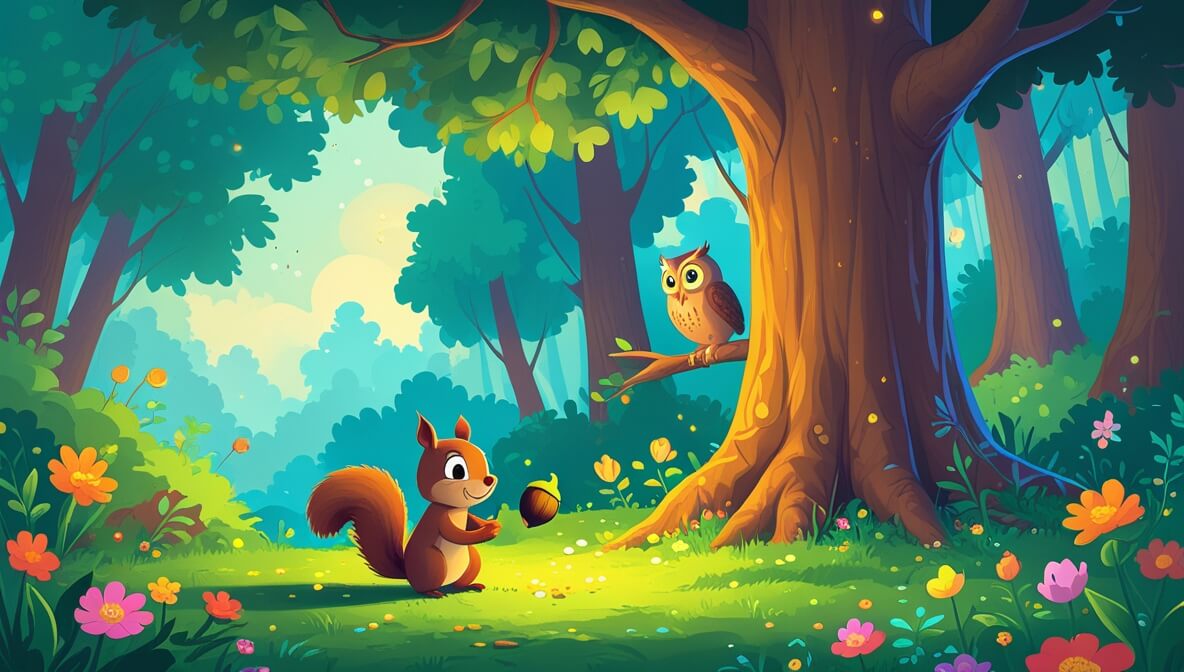A curious little squirrel discovers a magical acorn in the forest. With the help of a wise owl, he learns about its secrets.
Age Recommendation
0 – 4 years
Characters
Characters:
- Nutty (a curious and playful squirrel)
- Hoot (a wise and gentle owl)
Story
Once upon a time, in a colorful forest full of tall trees and chirping birds, there lived a little squirrel named Nutty. Nutty loved to explore and find new things. One sunny day, Nutty found a shiny acorn glowing under a big oak tree.
The Shiny Acorn
“Wow, what is this?” Nutty wondered, his eyes sparkling with curiosity. He picked up the acorn, and as he touched it, it began to glow even brighter. Just then, Hoot, the wise owl, flew down from his tree to see what Nutty had found.
Hoot’s Advice
“Hello, Nutty,” said Hoot. “That acorn is very special. It has a magical power that can make the forest bloom with colorful flowers!” Nutty was so excited. “Can we make it happen?” he asked eagerly.
Magic Unleashed
Hoot nodded and said, “Yes, but we must work together. You will plant it, and I will say the magic words.” Nutty quickly dug a small hole in the ground and gently placed the acorn inside. Hoot then whispered the magic words, and suddenly, the whole forest was filled with bright, beautiful flowers!
Nutty and Hoot were amazed at how the forest looked. “Thank you, Hoot,” said Nutty, giving his owl friend a big hug. From that day on, Nutty knew the power of working together and sharing magic with friends.
The end.
Moral of the Story
The story teaches the importance of teamwork and how working together can create beautiful things. It also highlights the value of curiosity and exploring the world around us.
Questions to Think About
- Why was the acorn special?
- How did Nutty and Hoot make the forest bloom?
- What did Nutty learn from Hoot?
- How do you feel when you work with a friend?
- Can you think of a time you worked with someone to do something special?
Do You Know
- Owls are known for their keen eyesight and can see in the dark!
- Squirrels plant thousands of new trees each year simply by forgetting where they hid their acorns.
Word Explorer
- Curious: Wanting to learn or know more about something.
- Magical: Having special and wonderful powers.
- Bloom: When a flower opens up and blossoms.
Emotions in the Story
- Curiosity: Nutty felt curious when he saw the shiny acorn.
- Excitement: Nutty was excited to see what the acorn could do.
- Happiness: Nutty felt happy when the forest bloomed with flowers.
Color Your Scene
Imagine the forest filled with colorful flowers after Nutty and Hoot make the magic happen. Draw the scene with bright reds, yellows, and pinks for the flowers, and don’t forget the green trees and blue sky. How does Nutty look when he sees the beautiful flowers?
Parents’ Corner
This story is an excellent opportunity to discuss the value of sharing and teamwork with your child. Encourage them to share their toys or work on a small project with a friend or sibling, emphasizing the joy and success that come from working together. Use Nutty and Hoot’s adventure to remind your child of the wonders that can happen when we explore and learn with others.











